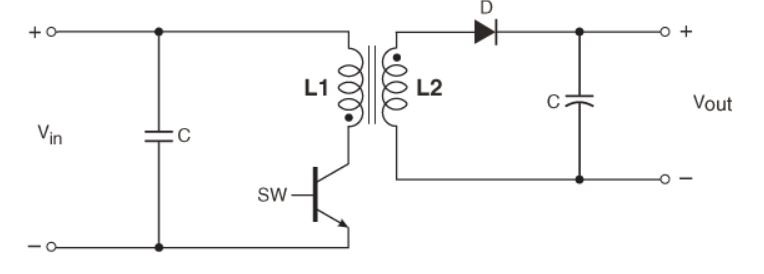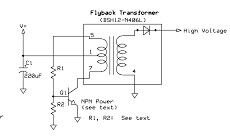Easy peasy
Advanced Member level 6
Most power electronics engineers would say that a typical ferrite flyback transformer needs a gap.
This is because a flyback transformer is a " store & release " converter - i.e. it stores energy in the gap ( and a teeny bit in the core ) and then releases the stored energy to the output at turn off.
At very low power you can use a toroidal ferrite with no gap to transfer some power ( like the very old circuit in the picture above ), actually you could use an Fe-powder or Kool-mu or amorphous toroid too for a bit more power - but what about for real power..? - a Tx with no gap?
Turns out you can. (see below for the spoiler **)
This is because the transformer function in a flyback is really only there to provide isolation ( and it also gives you a +ve output compared to the non-isolated buck-boost version - which is only -ve output )
Soooo... you can have a tightly coupled, zero gap transformer (or a more loosely coupled one that gives say 6kV isolation, if you wish, still no gap ) and use it in a flyback - but we need one more element to complete the picture...
A separate inductor - yes we need to store energy somewhere - so we can in fact slap an inductor across the secondary winding ( i.e. in parallel ) to do our bidding - and complete the power circuit. This is useful where you already have the transformer - but just want to put it in a flyback to transfer some power over an isolation boundary.
Further, we are not limited to the sec side, we can put an L on the pri side, we can put L's on both sides - it will still operate as a standard flyback ( check you do not run the chokes to saturation - as you would for a gapped transformer).
One particular use is at high frequency, the transformer can be optimised to pass 500kHz ( or much higher ) with low losses ( no fringing losses due to the gap ) and the sec side choke can be optimised for the role it plays - gapped - litz wire - etc ...
And where you already have a transformer for high isolation needs (gate drive power for multilevel inverter for example) you can now add a choke and fashion a flyback with a constant power drive ( constant pwm & Vin = constant power )
Often overlooked - this version of the flyback can be very useful.
pwrtrnx.com
** Spoiler, adding a separate L to the secondary, or primary, or both, gives the same performance as a gapped core in the Tx. This is because the flyback is an integration of the buck-boost converter with a transformer for isolation and inverted output...
And finally - just to complete the picture - as experienced designers will know, any low mu toroid ( or other shape ) can be used to form a flyback with no gap - as the energy is distributed throughout the material in exactly the same way it isn't for a high mu toroid - e.g. ferrite. For lowest Lleak, you would wind the pri in a continuous layer on a low mu toroid in T.I.W. ( triple ins wire ) and the secondary ( ies ) on top of this using tri-filar PUR-II or similar ... you can put another pri on top for 1/4 the leakage again, if you need this.

 www.linkedin.com
www.linkedin.com
This is because a flyback transformer is a " store & release " converter - i.e. it stores energy in the gap ( and a teeny bit in the core ) and then releases the stored energy to the output at turn off.
At very low power you can use a toroidal ferrite with no gap to transfer some power ( like the very old circuit in the picture above ), actually you could use an Fe-powder or Kool-mu or amorphous toroid too for a bit more power - but what about for real power..? - a Tx with no gap?
Turns out you can. (see below for the spoiler **)
This is because the transformer function in a flyback is really only there to provide isolation ( and it also gives you a +ve output compared to the non-isolated buck-boost version - which is only -ve output )
Soooo... you can have a tightly coupled, zero gap transformer (or a more loosely coupled one that gives say 6kV isolation, if you wish, still no gap ) and use it in a flyback - but we need one more element to complete the picture...
A separate inductor - yes we need to store energy somewhere - so we can in fact slap an inductor across the secondary winding ( i.e. in parallel ) to do our bidding - and complete the power circuit. This is useful where you already have the transformer - but just want to put it in a flyback to transfer some power over an isolation boundary.
Further, we are not limited to the sec side, we can put an L on the pri side, we can put L's on both sides - it will still operate as a standard flyback ( check you do not run the chokes to saturation - as you would for a gapped transformer).
One particular use is at high frequency, the transformer can be optimised to pass 500kHz ( or much higher ) with low losses ( no fringing losses due to the gap ) and the sec side choke can be optimised for the role it plays - gapped - litz wire - etc ...
And where you already have a transformer for high isolation needs (gate drive power for multilevel inverter for example) you can now add a choke and fashion a flyback with a constant power drive ( constant pwm & Vin = constant power )
Often overlooked - this version of the flyback can be very useful.
pwrtrnx.com
** Spoiler, adding a separate L to the secondary, or primary, or both, gives the same performance as a gapped core in the Tx. This is because the flyback is an integration of the buck-boost converter with a transformer for isolation and inverted output...
And finally - just to complete the picture - as experienced designers will know, any low mu toroid ( or other shape ) can be used to form a flyback with no gap - as the energy is distributed throughout the material in exactly the same way it isn't for a high mu toroid - e.g. ferrite. For lowest Lleak, you would wind the pri in a continuous layer on a low mu toroid in T.I.W. ( triple ins wire ) and the secondary ( ies ) on top of this using tri-filar PUR-II or similar ... you can put another pri on top for 1/4 the leakage again, if you need this.

Flyback transformer with no gap..(.!.?.)
Most power electronics engineers would say that a typical ferrite flyback transformer needs a gap. This is because a flyback transformer is a " store & release " converter - i.
 www.linkedin.com
www.linkedin.com
